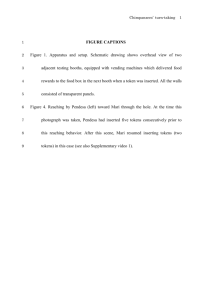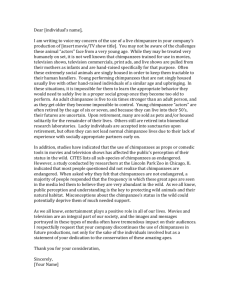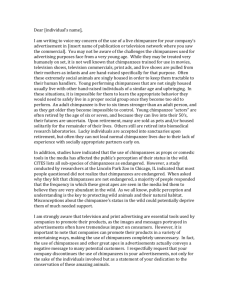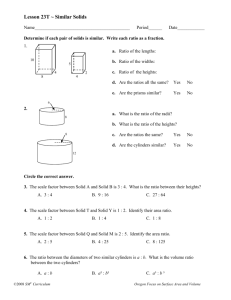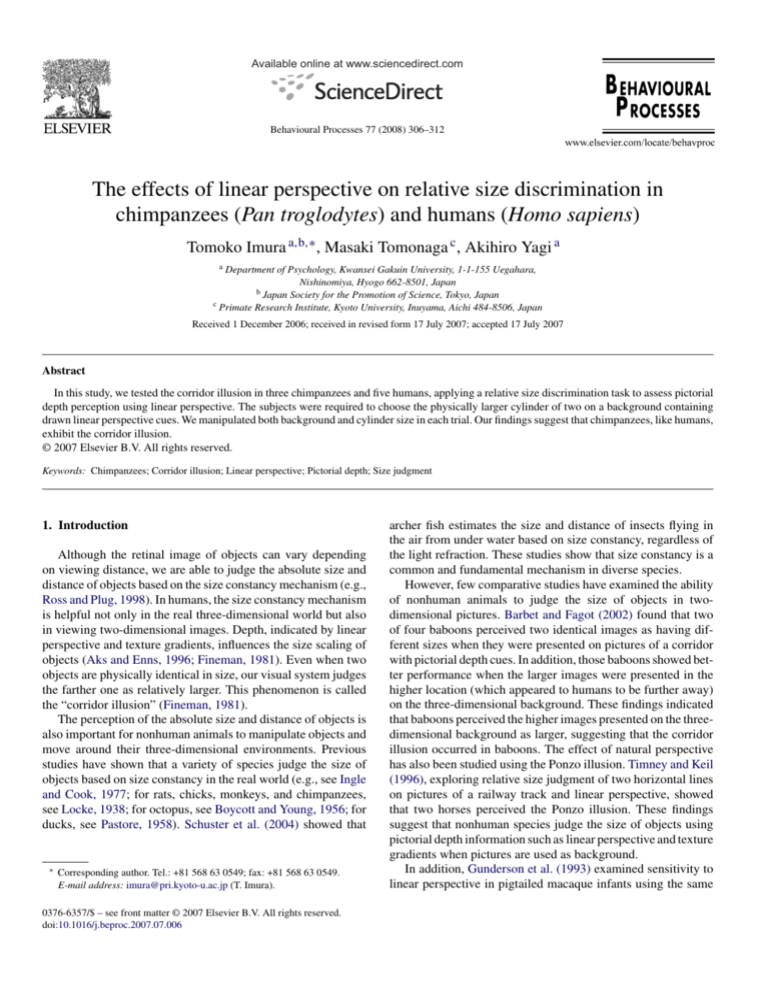
Available online at www.sciencedirect.com
Behavioural Processes 77 (2008) 306–312
The effects of linear perspective on relative size discrimination in
chimpanzees (Pan troglodytes) and humans (Homo sapiens)
Tomoko Imura a,b,∗ , Masaki Tomonaga c , Akihiro Yagi a
a
Department of Psychology, Kwansei Gakuin University, 1-1-155 Uegahara,
Nishinomiya, Hyogo 662-8501, Japan
b Japan Society for the Promotion of Science, Tokyo, Japan
c Primate Research Institute, Kyoto University, Inuyama, Aichi 484-8506, Japan
Received 1 December 2006; received in revised form 17 July 2007; accepted 17 July 2007
Abstract
In this study, we tested the corridor illusion in three chimpanzees and five humans, applying a relative size discrimination task to assess pictorial
depth perception using linear perspective. The subjects were required to choose the physically larger cylinder of two on a background containing
drawn linear perspective cues. We manipulated both background and cylinder size in each trial. Our findings suggest that chimpanzees, like humans,
exhibit the corridor illusion.
© 2007 Elsevier B.V. All rights reserved.
Keywords: Chimpanzees; Corridor illusion; Linear perspective; Pictorial depth; Size judgment
1. Introduction
Although the retinal image of objects can vary depending
on viewing distance, we are able to judge the absolute size and
distance of objects based on the size constancy mechanism (e.g.,
Ross and Plug, 1998). In humans, the size constancy mechanism
is helpful not only in the real three-dimensional world but also
in viewing two-dimensional images. Depth, indicated by linear
perspective and texture gradients, influences the size scaling of
objects (Aks and Enns, 1996; Fineman, 1981). Even when two
objects are physically identical in size, our visual system judges
the farther one as relatively larger. This phenomenon is called
the “corridor illusion” (Fineman, 1981).
The perception of the absolute size and distance of objects is
also important for nonhuman animals to manipulate objects and
move around their three-dimensional environments. Previous
studies have shown that a variety of species judge the size of
objects based on size constancy in the real world (e.g., see Ingle
and Cook, 1977; for rats, chicks, monkeys, and chimpanzees,
see Locke, 1938; for octopus, see Boycott and Young, 1956; for
ducks, see Pastore, 1958). Schuster et al. (2004) showed that
∗
Corresponding author. Tel.: +81 568 63 0549; fax: +81 568 63 0549.
E-mail address: imura@pri.kyoto-u.ac.jp (T. Imura).
0376-6357/$ – see front matter © 2007 Elsevier B.V. All rights reserved.
doi:10.1016/j.beproc.2007.07.006
archer fish estimates the size and distance of insects flying in
the air from under water based on size constancy, regardless of
the light refraction. These studies show that size constancy is a
common and fundamental mechanism in diverse species.
However, few comparative studies have examined the ability
of nonhuman animals to judge the size of objects in twodimensional pictures. Barbet and Fagot (2002) found that two
of four baboons perceived two identical images as having different sizes when they were presented on pictures of a corridor
with pictorial depth cues. In addition, those baboons showed better performance when the larger images were presented in the
higher location (which appeared to humans to be further away)
on the three-dimensional background. These findings indicated
that baboons perceived the higher images presented on the threedimensional background as larger, suggesting that the corridor
illusion occurred in baboons. The effect of natural perspective
has also been studied using the Ponzo illusion. Timney and Keil
(1996), exploring relative size judgment of two horizontal lines
on pictures of a railway track and linear perspective, showed
that two horses perceived the Ponzo illusion. These findings
suggest that nonhuman species judge the size of objects using
pictorial depth information such as linear perspective and texture
gradients when pictures are used as background.
In addition, Gunderson et al. (1993) examined sensitivity to
linear perspective in pigtailed macaque infants using the same
T. Imura et al. / Behavioural Processes 77 (2008) 306–312
preferential reaching tasks used for human infants (Yonas et al.,
1985). They showed that infant pigtailed macaques aged 7 and 8
weeks discriminated distances between objects on line drawings
based on linear perspective, texture gradients, and relative size,
in that order. In humans, 7-month-old infants more frequently
reached for closer objects based on texture gradient, relative size,
and linear perspective, in that order (Yonas et al., 1985, 1986).
Considering the different rates of development of these species
(cf., Boothe et al., 1985), the perception of the size and distance
of objects from pictorial depth cues develops around the same
time in both human and macaque infants.
In contrast, Fujita (1996, 1997) compared the perception of
the Ponzo illusion across humans, chimpanzees, rhesus monkeys, and pigeons. He showed that while all of the species
perceived the Ponzo illusion, the magnitude of the illusion and
the effects of backgrounds were different across species. In
pigeons, the magnitude of the illusion was much stronger than
in primate species. In humans, pictures of highways induced
a stronger illusion than two converging lines, while rhesus
macaques displayed the opposite pattern. These findings suggest differences by species in the effects of depth information
for the Ponzo illusion. However, further comparative studies
are necessary to explain the effects of different backgrounds on
different species.
In this study, we examined the ability of pictorial depth
perception with linear perspective in chimpanzees, a phylogenetically proximal species to humans. Most previous studies used
pictures with richer depth cues as backgrounds, such as texture gradients, relative size, and aerial perspective. To explore
the effects of other types of background, we investigated the
effects of line drawings with linear perspective on relative size
discrimination of objects. We compared the effects of the corridor illusion and linear perspective in three chimpanzees and five
humans.
2. Methods
2.1. Participants
Three adult chimpanzees (Pan troglodytes), Akira (male, 26
years old), Pendesa (female, 24 years old), and Chloe (female,
21 years old) participated in our experiments. They had already
participated in various experiments on perception and cognition (e.g., Fujita, 1997; Tomonaga, 1998). They lived in a social
group of 11 individuals in an environmentally enriched outdoor
enclosure (approximately 700 m2 ; see Ochiai and Matsuzawa,
1998). They were not food-deprived and were fed fruits, vegetables and other foods three times a day during the period of
experimentation. Care and use of the chimpanzees adhered to
the 2002 version of the “Guide for the Care and Use of Laboratory Primates” issued by the Primate Research Institute, Kyoto
University, Japan. Our research design was approved by the
institute’s Animal Welfare and Animal Care Committee.
Five humans (three males and two females, between 22 and 27
years old) also participated in the experiments. All had normal or
corrected-to-normal visual acuity and color vision, and all were
naive as to the purpose of the experiment prior to participation.
307
2.2. Apparatus
The participants were tested inside an experimental compartment (1.8 m × 2.15 m × 1.75 m) adjacent to the chimpanzee
facility. A 21-in CRT monitor (NEC PC-KH2021) with an optical touch panel (Microtouch SM-T2) was attached to one side
of the wall about 40 cm above the floor. The resolution of
the monitor was 640 × 400 pixels. The viewing distance was
kept at approximately 40 cm, so the length of 1◦ corresponded
approximately to 7 mm (13 pixels). A food dispenser (Biomedica BUF-310) delivered rewards to the food tray attached below
the monitor. A personal computer (NEC PC-9821 Xn) controlled
the stimulus presentation, detected touch on the CRT, delivered
the rewards, and collected data.
2.3. Stimuli
Fig. 1 illustrates examples of stimuli used in these experiments. The stimulus displays consisted of two gray cylinders
and contained two different backgrounds: pictures drawn in linear perspective, and a white background. A vanishing point was
located at either side of a picture to counterbalance the effects
of their positions on choice. All images were 340 × 340 pixels on the monitor. There were five different sizes of cylinders
(36, 38, 40, 42, and 44 pixels in height and diameter), and all
possible combinations of the five cylinders were used in this
experiment. There were four types of cylinder configuration.
The cylinders were arranged above or below a vanishing point
to counterbalance the target position. In the ceiling configuration, cylinders were turned upside down and put on the upper
side to ground the “ceiling” in a picture; in the floor configuration, cylinders were put on the lower side to indicate the “floor”
in a picture. The cylinders and backgrounds were painted black
(0.04 cd/m2 ).
We prepared conditions that would or would not produce the
corridor illusion by changing the combinations of the cylinder
and background configurations. The conditions were divided
into same-size trials in which the two cylinders were of identical size, and different-size trials in which one of the cylinders
was larger than the other. The same-size trials were further
divided into the following two conditions: “different-distance,”
in which two cylinders were arranged at different distances
on a picture with linear perspective; and “same-distance,” in
which although the configurations of two cylinders were identical to that of different-distance, they appeared to be on the
same fronto-parallel plane. If linear perspective affects the relative size judgment of cylinders, the percentage of choosing
cylinders closer to a vanishing point should be higher under
the different-distance condition than the same-distance condition. The different-size trials were divided into following three
conditions: “far-larger,” in which a larger cylinder was arranged
near the vanishing point; “far-smaller,” in which a smaller cylinder was arranged near the vanishing point; and “same-distance,”
in which although the configurations of the two cylinders were
identical to that under the far-larger and far-smaller conditions,
they appeared to be on the same fronto-parallel plane. Under
the far-larger and far-smaller conditions, two cylinders were
308
T. Imura et al. / Behavioural Processes 77 (2008) 306–312
Fig. 1. Examples of stimuli used in the experiment. The location of the vanishing point (VP) was changed to maintain the configuration of cylinders between
conditions.
T. Imura et al. / Behavioural Processes 77 (2008) 306–312
309
arranged at different distances on a picture with linear perspective. If depth from linear perspective cues affects the relative size
judgment of cylinders, we predicted that size judgment would
be easier under the far-larger condition than the same-distance
condition and would be more difficult under the far-smaller condition than the same-distance condition. This is because the size
perception of the cylinder presented near the vanishing point is
influenced by size constancy.
2.4. Procedure
2.4.1. General procedure
Each trial began after a touch to the blue circle (20 pixels
in diameter) appeared at the same distance from two cylinders.
The task was to touch the larger of two cylinders on various
backgrounds. As soon as the monitor was touched, or after an
elapse of 5 s, the stimuli disappeared. The intertrial interval (ITI)
was 2 s. For chimpanzees, a correct response produced a 1-s
chime and food reward, whereas an incorrect response produced
a 0.5-s buzzing noise. If participants made one error, the same
trial was repeated. If they made errors twice, the correct cylinder
alone was presented. For humans, a correct response produced
a 1-s chime, and no correction trials were given. Choices of
cylinders were nondifferentially reinforced under the same-size
condition.
2.4.2. Training and testing
First, each chimpanzee was trained on the relative size judgment of two cylinders using the combination of the most different
cylinders in size (36 and 44 pixels) on a white background. Each
training session consisted of 96 trials. Second, various combinations of cylinders were used. Each session consisted of 160 trials
consisting of 10 size combinations × 4 arrangements × 4 times.
Training continued until each subject’s performance reached
more than 90% correct in two consecutive sessions. First training phase consisted of two sessions for Akira and Pendesa
and three sessions for Chloe. A second training phase consisted of 4 sessions for Akira and Pendesa and 11 sessions for
Chloe.
Test sessions contained backgrounds with linear perspective
and any combination of cylinders. Each testing session consisted
of 105 trials, and each testing block contained 4 sessions. Chimpanzees underwent 10 testing blocks corresponding to 4200
trials. Human subjects underwent a single 420-trial session.
Fig. 2. Mean percentages of choosing the top cylinder by five humans during
the same trials. The error bar shows the standard error.
3. Results
3.1. Same-size trials
Figs. 2 and 3 show the mean percentages of trials in which the
human and chimpanzee participants, respectively, chose the top
cylinder in the same trials. In the “ceiling” configuration, both
humans and chimpanzees selected the top cylinder under the
different-distance condition less frequently than under the samedistance condition, while in the “floor” configuration, they chose
the top cylinder more frequently under the different-distance
than the same-distance condition. Three-way repeatedmeasures analyses of variance (ANOVAs) with cylinder size
(5) × configurations (ceiling vs. floor) × conditions (differentdistance vs. same-distance) were conducted for each species,
separately. In humans, we found significant main effects for
configurations (F(1,4) = 19.23, p < 0.05), size × configurations
(F(4,16) = 5.44, p < 0.01), and configurations × conditions
(F(1,4) = 101.25, p < 0.001). These findings suggest that in
humans, a higher percentage chose the top cylinders under the
different-distance condition than under the same-distance condition in the “floor” configuration. In contrast, this percentage
was lower under the different-distance condition than the samedistance condition in the “ceiling” configuration. These results
indicate that humans chose more cylinders closer to a vanishing point, at which cylinders appeared farther away, under the
2.5. Data analysis
We analyzed the data from same- and different-size trials
separately. In the same-size trials, the percentage of choosing
the top cylinder was used as the dependent variable. The average score was calculated across all cylinder sizes and compared
between the different- and same-distance conditions. In the
different-size trials, percentage of correct trials was compared
among the far-larger, far-smaller, and same-distance conditions.
Combinations of cylinders differing by 2 pixels were used
for data analysis, with other combinations treated as baseline
trials.
Fig. 3. Mean percentages of choosing the top cylinder by three chimpanzees
during the same trials. The error bar shows the standard error.
310
T. Imura et al. / Behavioural Processes 77 (2008) 306–312
Fig. 4. Mean percentage of correct trials for five humans during the different trials. (A) Far-smaller; (B) far-larger. The error bars show the standard error.
different-distance condition than under the same-distance condition. Thus, the corridor illusion occurred in humans. While
in chimpanzees, a repeated-measures ANOVA revealed a significant main effect of conditions (F(1,2) = 20.28, p < 0.05),
significant interactions of size × conditions (F(4,8) = 5.27,
p < 0.05), configurations × conditions (F(1,2) = 10.88, p = 0.08),
and size × configurations × conditions (F(4,8) = 5.73, p < 0.05).
Analyses of simple main effects revealed a significant difference
between different- and same-distance conditions in the “ceiling”
configuration (F(1,4) = 20.00, p < 0.05). These findings suggest
that in the “ceiling” configuration, chimpanzees chose fewer
top cylinders compared to bottom cylinders, which indicates
that chimpanzees more frequently chose the cylinders that the
humans perceived to be farther away. Thus, the results suggest
that the corridor illusion occurred in chimpanzees. However,
we did not find such evidence for chimpanzees in the “floor”
configuration.
3.2. Different-size trials
Figs. 4 and 5 show the average of the correct percentage
under each condition in humans and chimpanzees, respectively.
Under the far-smaller condition, performance was worse than
under the same-distance condition in both humans and chimpanzees, while under the far-larger condition, both species
performed relatively well, corresponding to performance under
the same-distance condition. For humans, we conducted a
repeated-measures two-way ANOVA of configurations (ceiling vs. floor) × conditions (far-smaller vs. same-distance) under
the far-smaller condition and found significant main effects for
conditions (F(1,4) = 24.89, p < 0.01), although no other main
effects or interactions were observed. Under the far-larger condition, a repeated-measures two-way ANOVA of configurations
(ceiling vs. floor) × conditions (far-larger vs. same-distance)
revealed no significant main effects or interactions. These findings suggest worse performance under the far-smaller condition
than the same-distance condition in humans. The corridor illusion might influence the performance of size discrimination.
In contrast, there were no differences in performance between
the same-distance and far-larger conditions, possibly reflecting the ceiling effect. For chimpanzees, a repeated-measures
ANOVA of configurations (ceiling vs. floor) × conditions (farsmaller vs. same-distance) × blocks (10) under the far-smaller
condition revealed a significant interaction for configurations × conditions (F(1,2) = 36.57, p < 0.05). Analyses of simple
main effect (Ryan’s procedure) revealed significant differences
between the far-smaller and same-distance conditions in the
“ceiling” configuration (F(1,2) = 36.57, p < 0.05). Under the
far-larger condition, a three-way repeated-measures ANOVA
of configurations (ceiling vs. floor) × conditions (far-larger vs.
same-distance) × blocks (10) showed significant main effects of
conditions (F(1,2) = 22.56, p < 0.05). Although the main effect
Fig. 5. Mean percentage of correct trials for three chimpanzees during the different trials. (A) Far-smaller; (B) far-larger. The error bars show the standard error.
T. Imura et al. / Behavioural Processes 77 (2008) 306–312
of blocks (F(9,18) = 2.90, p < 0.05) was significant, no significant correlation was observed across blocks. These findings
suggest that the chimpanzees performed better under the farlarger condition than under the same-distance condition, while
they performed worse under the far-smaller condition than the
same-distance condition only in the ceiling configuration. The
corridor illusion might affect the performance of size discrimination. However, the difference between the far-smaller condition
and the same-distance condition was not significant in the “floor”
configurations. Taken together with the findings for the samesize trials in chimpanzees, this result suggests that no clear
evidence of the corridor illusion exists among the chimpanzees
for the floor configuration.
4. Discussion
Our findings suggest that linear perspective cues contained
in the backgrounds of line drawings influence the relative size
judgment of objects in both chimpanzees and humans. The corridor illusion was observed in both species. These findings are
consistent with previous related studies (Barbet and Fagot, 2002;
Fujita, 1996).
Chimpanzees tended to exhibit the corridor illusion only
in the ceiling configuration in both the same- and differentsize trials. In contrast, humans exhibited no differences in the
magnitude of corridor illusion between floor and ceiling configurations.
These disparities between chimpanzees and humans suggest
that the information provided by the floor or ceiling differs
depending on species. This might be due to differences in the
environments the species have inhabited. Chimpanzees because
they adapted to an arboreal environment might be more sensitive to information from the ceiling than humans. Some studies
have shown that chimpanzees process spatial information in
different ways from humans. For example, humans perceive
three-dimensional shapes from shading based on two assumptions: (1) single light source and (2) lighting from above.
Previous studies suggest that, unlike humans, chimpanzees were
not influenced by location of a light source (Tomonaga, 1998).
We need further comparative studies in nonhuman animals to
examine the hypothesis of ecological constraints in spatial perception.
Another possibility is that cues used for such a task might
be different between species. Fujita (1996, 1997) suggested that
rhesus monkeys showed a weaker Ponzo illusion for the photographic background than for the background consisting of two
converging lines, whereas humans showed the opposite pattern.
These findings suggest that factors contributing to the Ponzo
illusion may be different among species. For chimpanzees in
this study, optical contact information from a ground surface
might not be so effective. Although the present study showed
the effects of linear perspective in chimpanzees and humans,
no studies have examined which factors influence depth perception by linear perspective in chimpanzees. For humans, the
perception of slant and depth from compression was greater than
those found in the convergence context (Andersen et al., 1998).
We need to explore what kind of factors in linear perspective
311
contributes to the perception of object size in chimpanzees and
humans.
These findings in humans and chimpanzees are seemingly
inconsistent with the “ground dominance effect”—that optical
contact information from the ground surface is more effective
for depth judgment of objects than ceiling surfaces (Bien et al.,
2005). If optical contact information provided by a ground surface is more important for size judgment of objects, the extent
of the corridor illusion should be larger for the floor configuration than for the ceiling configuration. A possible explanation
for the human findings is that information from a ground surface influences the depth judgment of cylinders even in ceiling
configurations. For example, under the same-distance condition
of the ceiling configuration, the distance between two cylinders
is identical to optical contact from the ceiling surface. However, if we judge the distances by information from the ground
surface, the top cylinder might be perceived to be farther away
than the bottom cylinders. Performance could be worse under
the same-distance condition in ceiling rather than in floor configurations because the perception of cylinder size is influenced
by size constancy. To dissociate the effectiveness of ground and
ceiling surfaces, we need further studies using stimuli in which
ground and ceiling contacts provide contradictory information
about spatial layout.
Acknowledgements
We thank Dr. Tetsuro Matsuzawa, Dr. Masayuki Tanaka,
and the staff of the Language and Intelligence Section and the
Center for Human Evolution Modeling Research of the Primate Research Institute for support throughout the research.
This study was supported by a Grant-in-Aid for Scientific
Research from the Japan Society for the Promotion of Science (no. 4414), Grants-in-Aid for Scientific Research (grants
10CE2005, 12002009), and a Grant-in-Aid for the 21st Century
COE Program (A2 to Kyoto University) from the Ministry of
Education, Culture, Sports, Science and Technology, Japan, and
by the Cooperative Research Program of the Primate Research
Institute, Kyoto University.
References
Aks, D.J., Enns, J.T., 1996. Visual search for size is influenced by a background texture gradient. J. Exp. Psychol.: Hum. Percept. Perform. 22, 1467–
1481.
Andersen, G.J., Braunstein, M.L., Saidpour, A., 1998. The perception of
depth and slant texture in three-dimensional scenes. Perception 27, 1087–
1106.
Barbet, I., Fagot, J., 2002. Perception of the corridor illusion by baboons (Papio
papio). Behav. Brain Res. 132, 111–115.
Bien, Z., Braunstein, M.L., Andersen, G.J., 2005. The ground dominance effect
in the perception of 3-D layout. Percept. Psychophys. 67, 802–815.
Boothe, R., Dobson, V., Teller, D., 1985. Postnatal development of vision in
human and nonhuman primates. Annu. Rev. Neurosci. 8, 495–545.
Boycott, B.B., Young, J.Z., 1956. Reactions to shape in Octopus vulgaris
Lamarck. Proc. Zool. Soc. (Lond.) 126, 491–547.
Fineman, M.B., 1981. Complexity of context and orientation of figure in the
corridor illusion. Percept. Mot. Skills 53, 11–14.
Fujita, K., 1996. Linear perspective and Ponzo illusion: a comparison between
rhesus monkeys and humans. Jpn. Psychol. Res. 38, 136–145.
312
T. Imura et al. / Behavioural Processes 77 (2008) 306–312
Fujita, K., 1997. Linear perspective and the Ponzo illusion by rhesus monkeys,
chimpanzees, and humans: similarity and difference in the three primate
species. Percept. Psychophys. 59, 284–292.
Gunderson, V.M., Yonas, A., Sargent, P.L., Grant-Webster, K.S., 1993. Infant
macaque monkeys respond to pictorial depth. Psychol. Sci. 4, 93–98.
Ingle, D., Cook, J., 1977. The effect of viewing distance upon size preference
of frogs for prey. Vis. Res. 17, 1009–1013.
Locke, N.M., 1938. Perception and intelligence: their phylogenetic relation.
Psychol. Rev. 45, 335–345.
Ochiai, T., Matsuzawa, T., 1998. Planting trees in an outdoor compound of chimpanzees for an enriched environment. In: Hare, V.J., Worley, K.E. (Eds.),
Proceedings of the Third International Conference on Environmental Enrichment. 12–17 October 1997, The Shape of Enrichment, Orlando, FL, pp.
355–364.
Pastore, N., 1958. Form perception and size constancy in the duckling. J. Psychol.
45, 259–261.
Ross, H.E., Plug, C., 1998. The history of size constancy and size illusions. In: Walsh, V., Kulikowski, J.J. (Eds.), Perceptual Constancies: Why
Things Look as They Do. Cambridge University Press, Cambridge, UK, pp.
499–528.
Schuster, S., Rossel, S., Schmidtmann, A., Jager, I., Poralla, J., 2004. Archer
fish learn to compensate for complex optical distortions to determine the
absolute size of their aerial prey. Curr. Biol. 14, 1565–1568.
Tomonaga, M., 1998. Perception of shape from shading in chimpanzees (Pan
troglodytes) and humans (Homo sapiens). Anim. Cogn. 1, 25–35.
Timney, B., Keil, K., 1996. Horses are sensitive to pictorial depth cues. Perception 25, 1121–1128.
Yonas, A., Granrud, C.E., Pettersen, L., 1985. Infants’ sensitivity to relative size
information for distance. Dev. Psychol. 21, 161–167.
Yonas, A., Granrud, C.E., Arterberry, M.E., Hanson, B.L., 1986. Infants’ distance perception from linear perspective and texture gradients. Infant Behav.
Dev. 9, 247–257.



